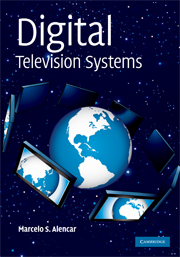Book contents
- Frontmatter
- Contents
- List of figures
- List of tables
- List of contributors
- Preface
- Acknowledgments
- 1 Fundamentals of digital television
- 2 Audio and video coding
- 3 Fundamentals and standards of video and audio compression
- 4 Channel coding for digital television
- 5 Digital and analog transmission systems
- 6 Advanced Television Systems Committee standard (ATSC)
- 7 Digital video broadcasting (DVB)
- 8 International Services Digital Broadcasting for Terrestrial Television Broadcasting (ISDB)
- 9 International System for Digital Television (ISDTV)
- 10 Digital terrestrial television multimedia broadcasting (DTMB)
- Appendix A Evolution of television standards
- Appendix B Signal analysis
- Appendix C Random signals and noise
- Glossary
- References
- Index
4 - Channel coding for digital television
Published online by Cambridge University Press: 28 January 2010
- Frontmatter
- Contents
- List of figures
- List of tables
- List of contributors
- Preface
- Acknowledgments
- 1 Fundamentals of digital television
- 2 Audio and video coding
- 3 Fundamentals and standards of video and audio compression
- 4 Channel coding for digital television
- 5 Digital and analog transmission systems
- 6 Advanced Television Systems Committee standard (ATSC)
- 7 Digital video broadcasting (DVB)
- 8 International Services Digital Broadcasting for Terrestrial Television Broadcasting (ISDB)
- 9 International System for Digital Television (ISDTV)
- 10 Digital terrestrial television multimedia broadcasting (DTMB)
- Appendix A Evolution of television standards
- Appendix B Signal analysis
- Appendix C Random signals and noise
- Glossary
- References
- Index
Summary
Introduction
Reliable information transmission and storage has been a constant challenge for engineers and researchers in telecommunications due to the ever increasing demands for higher processing speeds and higher reliability. Error-correcting codes (Shannon, 1948a, Peterson and Weldon, 1972) are nowadays found in most electronic digital processing equipment, from the audio compact disk (CD) (Wicker and Bhargava, 1994) to deepspace probes (Hagenauer, 1992), and more recently in digital television.
The purpose of this chapter is to focus on specific coding schemes employed for digital television, covering a minimum of background material on error-correcting codes. The term reliability in telecommunications refers to the level of signal immunity to noise and interference, and is not concerned with secrecy or authenticity of the data. Cyclic codes (Lin and Palais, 1986) include important subclasses of codes, e.g., the Bose–Chaudhury–Hocquenghem (BCH) codes, the Reed–Solomon codes, and practical low-density parity-check (LDPC) codes, and for this reason are the subject of the next section. In Section 4.5 another important class of codes, the convolutional codes, will be addressed.
Cyclic codes
Cyclic codes are among the most important codes for practical applications in engineering (Lin and Palais, 1986). Cyclic codes have been used as part of many communication protocols, in music CDs, in magnetic recording (Immink, 1991), etc. The preference for cyclic codes is a consequence of their mathematical structure based on discrete mathematics, which allows a considerable simplification in the implementation of encoders and decoders for such codes. A formal mathematical treatment of q-ary cyclic codes relies on polynomial rings (Peterson and Weldon, 1972), modulo xn – 1, with coefficients in the Galois field GF(q), in which n denotes the code block length (Berlekamp, 1968).
- Type
- Chapter
- Information
- Digital Television Systems , pp. 65 - 93Publisher: Cambridge University PressPrint publication year: 2009



